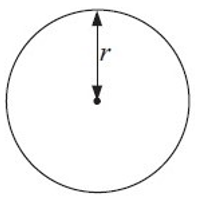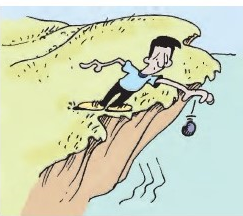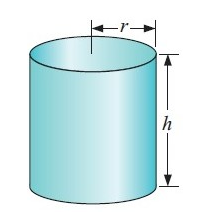SOLVING WORD PROBLEMS IN EVALUATING FUNCTIONS
Example 1 :
The formula for finding the circumference C of a circle with radius r is C = 2∏r.
Find :
a) The circumference of a circle of radius 4.2 cm.
b) The radius of a circle with circumference 112 cm.
c) The diameter of a circle with circumference 400 meters.

Solution :
(a) Radius (r) = 4.2 cm
Circumference of a circle C = 2∏r
= 2 × 22/7 × 4.2
= 26.4
cm
So, circumference of a circle C is 26.4 cm.
(b) Circumference C = 112 cm
112
= 2 × 22/7 × r
r
= 17.8 cm
So, radius of a circle r is 17.8 cm.
(c) Circumference C = 400 m
400
= 2 × 22/7 × r
r
= 63.63 m
diameter (d) = 2r
d = 2(63.63)m
d = 127.3 m
So, diameter of a circle r is 127.3 m.
Example 2 :
When a stone is dropped from the top of a cliff, the total distance fallen is given by the formula
D = 1/2gt2
where D is the distance in meters and t is the time taken in seconds. Given that g = 9.8 ms-2,
Find :
a) The total distance fallen in the first 2 seconds of fall
b) The height of the cliff, to the nearest metre, if the stone takes 4.8 seconds to hit the ground.

Solution :
(a) Time t = 2 seconds and g = 9.8 ms-2
D = 1/2gt2
D = 1/2 ⋅ (9.8) ⋅ 22
= 1/2
(39.2)
D = 19.6 m
So, the total distance D is 19.6 m.
Time t = 4.8 seconds
D = 1/2gt2
D = 1/2 ⋅ (9.8) ⋅ (4.8)2
= (1/2) (225.79)
D = 112.9 m
So, height of the cliff is 112.9 m
Example 3 :
When a car travels a distance d kilometers in time t hours, the average speed for the journey is given by the formula
s = d/t kmh-1
Find :
(a) The distance travelled by a car in 2 3/4 hours if its average speed is 80 kmh-1.
(b) The time taken, to the nearest minute, for a car travel 790 km at an average speed of 95 kmh-1
Solution :
(a) t = 11/4 hrs and s = 80 kmh-1
s = d/t kmh-1
80 = d/(11/4)
d = (880/4)
= 220 km
So, distance travelled by a car is 220 km.
(b) d = 790 km and s = 95 kmh-1
s = (d/t) kmh-1
95 = 790/t
t = 8.316 hrs
t = (8 + 0.316) hrs
t = 8 hr (0.316 × 60) min
t = 8 hr 19 min
So, time taken 8 hr 19 min
Example 4 :
A circle’ s area A is given by
A = ∏r2
where r is the length of its radius.
Find :
(a) the area of a circle radius 6.4 cm
(b) the radius of a circular swimming pool which has an area of 160 m2
Solution :
(a) radius (r) = 6.4 cm
Area of a circle A = ∏r2
A = (22/7) × 6.4 × 6.4
A
= 128.7 cm2
So, area of a circle is 128.7 cm2
(b) Area = 160 m2
Area of a circle A = ∏r2
160 = (22/7) × r2
r2
= 50.90
r
= 7.14 m
So, the radius of a circular swimming pool is 7.14 m
Example 5 :
A cylinder of radius r and height h has volume given by
V = ∏r2h
Find :
(a) the volume of a cylindrical tin can of radius 8 cm and height 21.2 cm.
(b) the height of a cylinder of radius 6 cm and volume 120 cm3
(c) the radius, in mm, of a copper pipe of volume 470 cm3 and length 6 m

Solution :
radius (r) = 8 cm and height (h) = 21.2 cm
Volume of cylinder = ∏r2h
V = 22/7 × 82 × 21.2
V
= 4264.2 cm3
So, the volume of a cylindrical tin is 4264.2 cm3
(b) radius = 6 cm and volume = 120 cm3
Volume of cylinder = ∏r2h
120 = 22/7 × 62 × h
(840/792)
= h
h = 1.06 cm
So, the height of a cylinder is 1.06 cm
volume = 470 cm3
V = 470 cm3
height = 6 m, h = 600 cm
Volume of cylinder = ∏r2h
470 = 22/7 × r2 × 600
(470 × 7)/(22 × 600) = r2
r2
= 0.2492
r
= 0.499 cm
r = 4.99 mm
So, the radius is 4.99 mm.
Example 6 :
If p is a positive integer greater than 1, which of the following must be negative?
(A) 5 - p (B) 2p - 6 (C) 1 - p (D) -p + 3 (E) 2p + 3
Solution :
Option A :
When p is 2
5 - p = 5 - 2 ==> 3( it is positive)
So, option A is incorrect.
Option B :
When p is 2
2p - 6 = 2(2) - 6 ==> -2( it is negative)
Since the value of p should be greater than 1 and it should be the integer, we assume the value of p as 2.
When p = 3
2p - 6 = 2(3) - 6 ==> 0
So, it is not always negative. Then option B is incorrect.
Option C :
|
When p = 2 = 1 - p = 1 - 2 = -1 |
When p = 3 = 1 - p = 1 - 3 = -2 |
When p = 4 = 1 - p = 1 - 4 = -3 |
It is always negative. So, option C is correct.
Kindly mail your feedback to v4formath@gmail.com
We always appreciate your feedback.
©All rights reserved. onlinemath4all.com
Recent Articles
-
Digital SAT Math Problems and Solutions (Part - 146)
Apr 18, 25 06:52 AM
Digital SAT Math Problems and Solutions (Part - 146) -
Logarithmic Derivative Problems and Solutions
Apr 16, 25 09:25 PM
Logarithmic Derivative Problems and Solutions -
Digital SAT Math Problems and Solutions (Part - 145)
Apr 16, 25 12:35 PM
Digital SAT Math Problems and Solutions (Part - 145)

